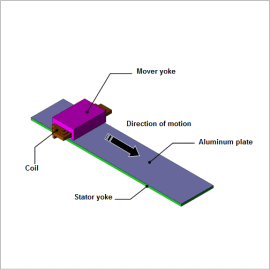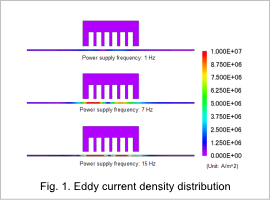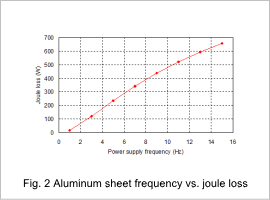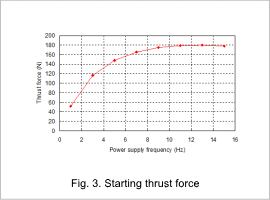*Please prepare a license ID and password for the license administrator.
*It is different from the service for JMAG WEB MEMBER (free membership). Please be careful.
Overview

Linear motors are widely used for carrier devices and machine tools because of their high-speed performance, high acceleration and deceleration, and accurate positioning. One type of linear motor, the linear induction motor, can be constructed at low cost because it can use a primary side with coils, and a secondary side made of a conductor that is not magnetized, such as aluminum or copper.
There are some problems when building a linear inductance motor, such as complex eddy currents flowing in the secondary conductor sheet, and a large amount of leakage flux between the mover and stator. In order to improve linear inductance motor efficiency, therefore, it is important to gain an understanding of the paths of eddy currents and the leakage flux. Evaluation using the finite element method (FEM) is useful for this.
This Application Note presents how to obtain the starting thrust force for a linear inductance motor.
There are some problems when building a linear inductance motor, such as complex eddy currents flowing in the secondary conductor sheet, and a large amount of leakage flux between the mover and stator. In order to improve linear inductance motor efficiency, therefore, it is important to gain an understanding of the paths of eddy currents and the leakage flux. Evaluation using the finite element method (FEM) is useful for this.
This Application Note presents how to obtain the starting thrust force for a linear inductance motor.
Eddy Current Density Distribution / Frequency of the Aluminum Sheet vs. the Joule Losses
The eddy current density distribution for each power supply frequency is indicated in fig. 1, and the aluminum sheet’s frequency vs. joule loss is indicated in fig. 2.
As indicated in fig. 1, eddy currents in the aluminum sheet increase as the power supply frequency becomes higher. This is because time variations in the magnetic flux acting on the aluminum sheet increase along with power supply frequency. As indicated in fig. 2, joule loss in the aluminum sheet increases as eddy currents increase.


Starting Thrust Force

The starting thrust force for power supply frequencies of 1 to 15 Hz is indicated in fig. 3.
As the figure shows, thrust force increases as the power supply frequency gets higher. This is because eddy currents in the aluminum sheet increase with higher power supply frequencies as shown in fig. 1. The maximum starting thrust force of this linear induction motor is approximately 180 N.
As the figure shows, thrust force increases as the power supply frequency gets higher. This is because eddy currents in the aluminum sheet increase with higher power supply frequencies as shown in fig. 1. The maximum starting thrust force of this linear induction motor is approximately 180 N.


